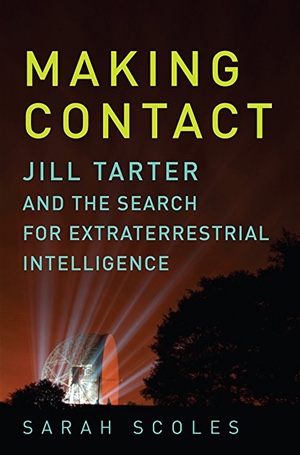Review: Making Contactby Jeff Foust
|
| Tarter read the Project Cyclops report and was hooked. Scoles compared it to a religious conversion, describing how, decades later, Tarter still had new students read the report. “She’s like a zealous convert, passing along the scripture that first inspired her.” |
The biggest name associated with SETI, though, might be Jill Tarter. As an astronomer, she spent nearly all her professional career on SETI research, participating in, advocating for, and managing key projects funded both by NASA and philanthropic sources. She was also the basis for Ellie Arroway, the main character in Sagan’s SETI novel Contact and later movie. They inspired a generation of astrobiologists and other scientists, particularly women who saw Arroway/Tarter as a role model.
Tarter, unlike her fictional counterpart, has yet to discover a signal from an extraterrestrial intelligence, but she has led a life as a SETI pioneer and leader that is no less interesting. In Making Contact, science writer Sarah Scoles offers a fascinating biography of Tarter and her devotion to a field that often attracts significant attention but rarely significant funding.
Tarter, Scoles writes, was not interested in the idea of looking for alien life in her childhood. Growing up she was fascinated with science and engineering, with the “desire, perhaps even the need, to ‘figure it out,’” as Scoles describes. She pursued engineering at Cornell in an era when very few women did, and then, after marrying a graduate student there and having a baby, decided to switch to astronomy, enrolling in the PhD program at the University of California Berkeley.
It was there where Tarter became involved in SETI. A professor asked her to read the final report of Project Cyclops, a study that proposed developing a dedicated radio observatory for SETI at the cost of several billion dollars. NASA never funded the concept, of course, but the report became a guiding document for SETI in its early years. Tarter read the report and was hooked. Scoles compared it to a religious conversion, describing how, decades later, Tarter still had new students read the report. “She’s like a zealous convert, passing along the scripture that first inspired her.”
Tarter remained involved in SETI throughout her career, working as a postdoc at Ames and later helping found the SETI Institute. While this took place, SETI support went on a roller coaster, with NASA offering modest funding only to face congressional criticism and the threat of termination. Those threats finally won out in 1993, when Sen. Richard Bryan of Nevada pushed through an amendment zeroing out finding for NASA’s High Resolution Microwave Survey. The federal government has yet to fund SETI efforts since, even as the broader field of astrobiology has gained support, and money, in the last two decades.
| “She may not have unearthed an extraterrestrial civilization or made the most important discovery of the human race, as Arroway did,” Scoles concludes. “But she helped SETI survive, and she helped others think bigger, be better, and stay stubborn.” |
Tarter and the rest of the SETI field have survived on shoestrings since, using private donations to help keep projects going. A couple of chapters (placed, oddly, out of chronological order in the early part of the book) describe the saga of the Allen Telescope Array, which got off to a bold start with financial support from Microsoft co-founder Paul Allen, but for which only a small fraction of its antennas have been constructed, more than 15 years after Allen agreed to support the project.
With Tarter retired from the SETI Institute, but still active in the field in her 70s, how should one judge her impact on both SETI and overall society? Some younger women astrobiologists, inspired by Tarter and/or Contact, suggest in interviews in the book that Tarter is disappointed in not having detected evidence of other civilizations. There’s also the impression that SETI has passed her by: the Breakthrough Listen project, funded for $100 million over ten years by Russian billionaire Yuri Milner, has reinvigorated the field but hasn’t involved Tarter or others at the SETI Institute.
Scoles argues that Tarter has played a significant role even if the searches she’s participated in failed to turn anything up. “She may not have unearthed an extraterrestrial civilization or made the most important discovery of the human race, as Arroway did,” she concludes. “But she helped SETI survive, and she helped others think bigger, be better, and stay stubborn.” That’s a worthy achievement, eloquently told in this book.
